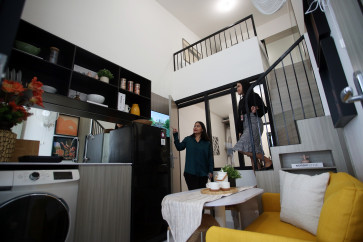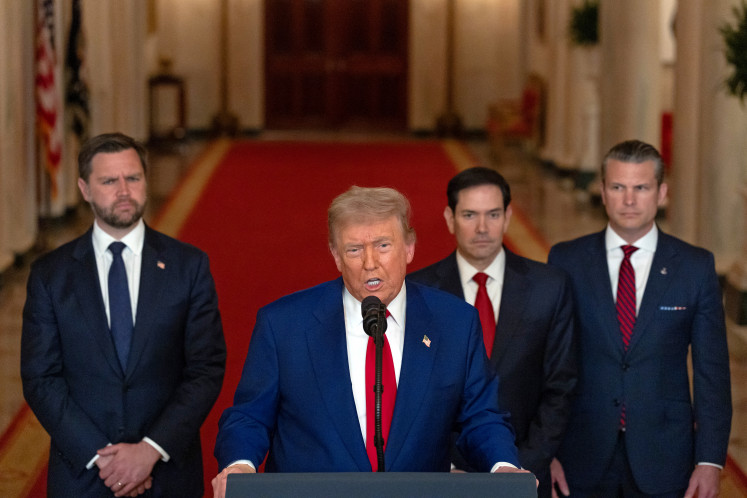Popular Reads
Top Results
Can't find what you're looking for?
View all search resultsPopular Reads
Top Results
Can't find what you're looking for?
View all search resultsReconnecting with earth at Leuwigoèng
Selasar Sunaryo Art Space’s "Pulang Pada Tanah" exhibition explores the experiences of eight artists in rediscovering their connection with the earth and the quintessence of life.
Change text size
Gift Premium Articles
to Anyone

S
elasar Sunaryo Art Space’s Pulang Pada Tanah exhibition explores the experience of eight artists in rediscovering their connection with the earth and the quintessence of life.
From whence we came and derived sustenance, humanity's relationship with earth (or soil) has grown more disconnected than ever.
Particularly during the COVID-19 lockdowns, where people acquire their means of nourishment through digital platforms, a large chunk of the populace’s perception of food and the conception of its existence eventually shifted.
We drifted even further from our already-distant relationship with the earth in today’s concrete-encumbered world, both physically and ideologically.
Selasar Sunaryo Art Space’s (SSAS) latest exhibition, Pulang Pada Tanah (Home to Soil), tells the journey of eight artists in search of their way back to earth, to the soil, in a hidden sanctuary in northern Bandung, West Java: Leuwigoèng.
The gathering of the eight
Leuwigoèng, a Sundanese word roughly translated as “a whirlpool in a river,” is a tranquil plot of land located on a valley just a stone’s throw away from one of Bandung’s busiest streets, Jl. Ir. H. Juanda (better known as Jalan Dago).
“It’s a foregone name of the place,” said Heru Hikayat, SSAS’s in-house curator to The Jakarta Post on Nov. 25. He told of the place in a way that is almost spiritual.
The haven is a private property kept somewhat separate from the modern world, surrounded by lush greenery and devoid of explicit visual cues of an urban environment. Its inhabitants follow a slower, seemingly fuller way of life where they unlearn modern habits and ultimately return to their natural tendencies. It is an oasis for those who yearn for connection with nature.
Two of the eight exhibiting artists, Prilla Tania and Adjo Akasia, started living in Leuwigoèng in 2016, long before the pandemic hit. As they settled in and started cultivating the paddy fields, the farm, and the pond in Leuwigoèng, friends started coming and things began to get livelier.
Pantomime artist Mumu Zainal Mutaqin joined Prilla and Adjo in 2017 to live at Leuwigoèng, followed by frequent visits by longtime friends and artists Terranova Waksman and Bambang Trisunu.
“In 2018, Bebe [Bambang’s nickname] forced us to join social media,” Prilla chuckled. “Then we got to know other planters [and] gardeners from there.”
Prilla and the others also got in touch with the family-of-three Agni Yoga Airlangga, Nur Aini and Arya Zen Ecologia through social media. The eight then bonded as a family in Leuwigoèng, where they shared ideas, ate together and talked over and about food.

Part-time farmers
The exhibition, however, was planned for a year before it started. “The point of the exhibition is to share the experience [of living in Leuwigoèng] and that’s exactly where the challenge lies,” Heru commented.
“How to present these experiences in the form of artworks. We spent a year discussing the options and ideas, taking everything apart and putting it together again.” Heru also visits Leuwigoèng often, looking for a space where his children can play out in the open and be in touch with nature, especially during the 2020 lockdowns.
The physical restrictions that the government imposed ultimately forced Prilla and Adjo’s initiative, Rumah Ramah (the hospitable house), in 2020. It was an initiative where people could visit Leuwigoèng and socialize while enjoying the local produce.
Prilla and Adjo then became part-time farmers, deriving their sustenance from the land amidst the lockdown while people in the city ordered food delivered to their door in plastic bags and boxes.
Through their experience in farming during the pandemic, Prilla and Adjo deduced that they were “unearthing the knowledge [and skills] that we have lost, or are losing, from being overlooked,” Heru wrote in the release.
“Urban culture considers that food is something that is given. Food is simply an industry that is massive and only measured in terms of profit. In fact, no matter how sophisticated the technological advances are and no matter the changes in human lifestyle, one thing does not change: We eat from the earth’s produce.”

Reconnecting
Heru noted that the most valuable aspect derived from living in Leuwigoèng is that “we reconnect ourselves with food sources, which are primary, yet always being overlooked. [...] We expect water to always run and fire to be lighted easily at will when those things can only actually be acquired with a certain set of efforts,” Heru continued.
“Our lives are connected with the earth, with a certain pattern of nature, where we need to be a part of. Not the other way around. Not to dominate but to be part of the earth’s rhythm; nature's rhythm.”
Pulang Pada Tanah takes up the whole Ruang B (Room B) at SSAS, where visitors are immediately greeted by a mind map drawn by the youngest exhibitor, Arya, 7, adjacent to the exhibition’s curatorial text. “These are both ordinary and unusual things simultaneously,” Heru chimed.
“Pond full of algae, well-trodden ground,” wrote Arya in his mind map. Through the corridor, I greeted a set of wooden poles arranged in such a way that it seemed to be holding together the room. A couple of dried produce were hung from the horizontal poles, which are usually used as seeds for new produce, an installation by Adjo, titled Penyangga I (Suspension I).
A wooden pillar is placed in the corner, complete with its foundation and the vegetation surrounding it, Adjo’s Penyangga II (Suspension II). Heru noted that the pillar’s significance was its social and functional aspects where they placed various things and engaged in conversations around the pillars.
Lining the longest wall in Ruang B is a series of recipes, overlooked by a 100 by 200-centimeter mural, both by Terranova, titled Recipes From Leuwigoèng and Sambel Lalab (Raw Vegetable Sambal), the latter was a collaborative work with Bambang. At the far end of the room, across an audio installation, deliberately leaked into the room and through a headphone, is a participative installation by Prilla where visitors are asked to draw on the wall with chalks around a bare trunk of a tree that is placed in the middle of the room.
Pulang Pada Tanah runs from Nov. 23 to Dec. 23, 2022, at Ruang B, Selasar Sunaryo Art Space.
Exhibitors:
Adjo Akasia
Agni Yoga Airlangga
Arya Zen Ecologia
Bambang Trisunu
Mumu Zainal Mutaqin
Nur Aini
Prilla Tania
Terranova Waksman
Curated by Heru Hikayat









